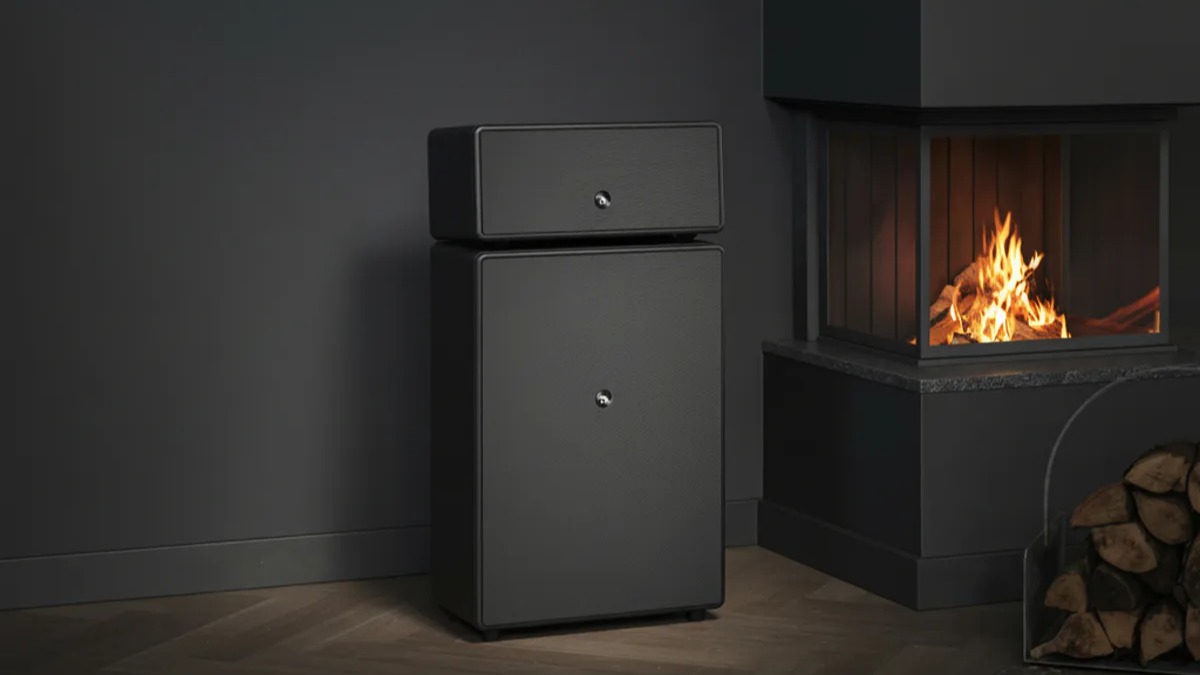A look back at the first What Hi-Fi? Awards, 1983
We travel back to where it all started
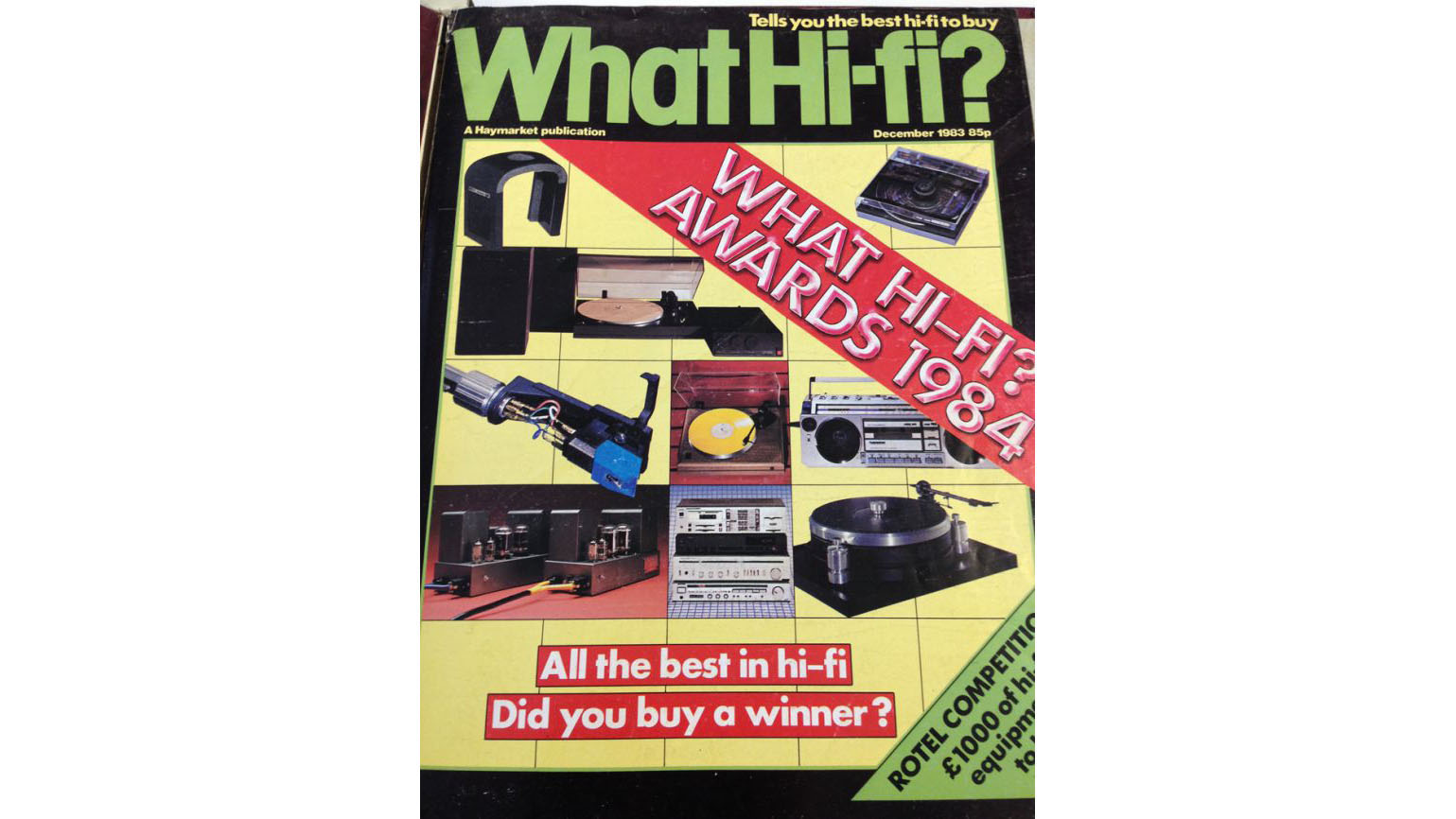
Once all our Best Buy Award-winners have been unveiled on Monday 5th October, the next big reveal is Thursday 5th November. This is the day we announce our Products of the Year in each of those categories - the crème de la crème, this year's truly outstanding product of its type.
In addition, we'll be giving Awards to our favourite 'Temptation' product (a money-no-object indulgence), to the year's best innovation and to the product most popular in our current readers' poll.
And we'll be announcing the latest entrant into our Hall of Fame - number 44 in our list of the very best products of 44 What Hi-Fi? years. The results will be live on this website on the evening of November 5th, and the chunky Awards issue of the magazine is on sale the next day.
The What Hi-Fi? Awards, in association with Sevenoaks Sound and Vision, have evolved with the hi-fi and home entertainment landscape ever since the first Awards in 1983. So as well as looking forward to this year's shindig, we're looking back to see just how far we've come...
1983 was a good year. CD players went on sale for the first time, Michael Jackson's Thriller was the best-selling album in the UK, and Return of the Jedi was released in cinemas. It was also the year of the first What Hi-Fi? Awards.
Our first ever round-up of the best products on the market was unveiled in the December 1983 issue of the magazine, with the inaugural Awards billed, somewhat confusingly, as the What Hi-Fi? Awards 1984.
85p bought you a copy of the largely black and white magazine, 13 pages of which were dedicated to revealing 84 nominated products across 14 categories - 'Products of the Year', as they would later become known.
The latest hi-fi, home cinema and tech news, reviews, buying advice and deals, direct to your inbox.
So what was the state of the art in 1983..?
How it worked
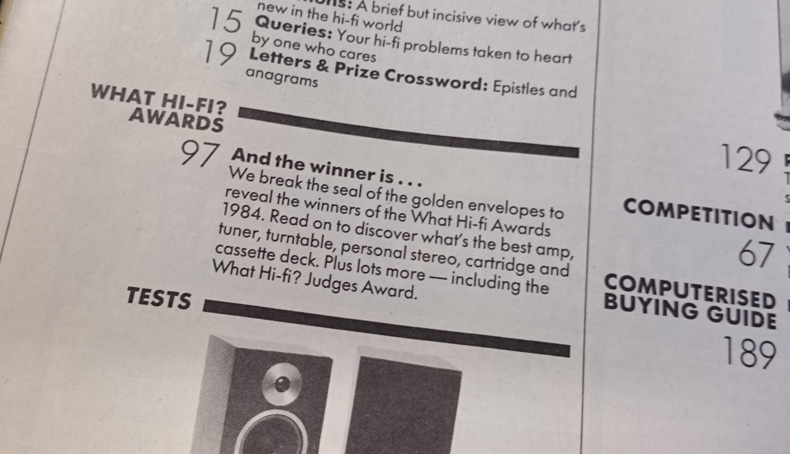
Looking back at the first incarnation, it's reassuring to see the premise of the Awards has remained broadly the same. They're just a good deal bigger now.
There were 14 categories back in 1983, compared to 30 this year, reflecting the breadth of products we now cover. And instead of 14 Product of the Year winners, there will be 104 Best Buys announced for 2017, with every category featuring winners at a range of prices.
But the criteria on which the products were judged have remained consistent. As we said back in 1983: "The most important yardstick was overall value for money". That's as true now as it was then.
Performance, reliability and design were the three further key considerations we noted first time around, though even then we were aware of the limitations of testing a product's reliability based on a relatively short period of review time.
The winners in 1983 were chosen by four judges - selected from "our most longstanding reviewers" - under the careful eye of the editor, Matt Nicholson. Now of course our review team is entirely in-house, and the Award-winners are thrashed out among the What Hi-Fi? team based on the previous 12 months of testing.
The categories
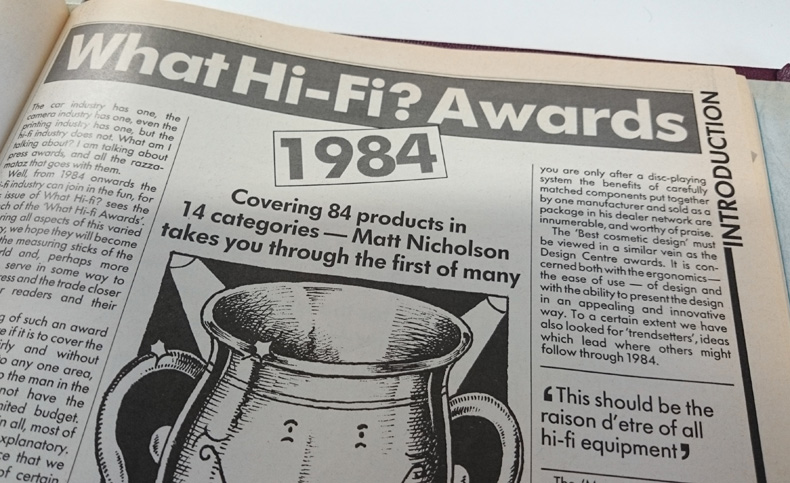
Back then, What Hi-Fi? was a dedicated stereo hi-fi magazine, aimed at both audio enthusiasts and the mass-market buyer who simply wanted advice on a new pair of speakers.
With the home cinema market in its infancy, our coverage of TVs and home cinema amplifiers was still some way off, let alone unimaginable-at-the-time product categories such as smartphones, tablets or streaming services.
The hi-fi market itself was a much more straightforward affair. There were no wireless speakers, no multi-room systems and, no doubt, far fewer pairs of headphones.
The first ever Awards categories read as follows: amplifiers, tuners, cassette decks, turntables, speakers, cartridges, headphones, systems, personals, portables, CD players, cosmetic design, most innovative and judges' Award.
So, no AV or streaming products, fewer portable product categories, a specialist cartridge category, and a couple of categories based on innovation and design. What else was new?
Birth of the CD player

Coincidentally, 1983 was the year that CD players first went on sale in the UK: "A brand new technology", was the headline in the Awards category page.
As ever, there was a mixture of excitement and trepidation as we covered this new digital format. But even back then, we had half an eye on the next-generation of digital storage.
"Compact discs are little shiny silver records that are going to replace black vinyl in the future," read the editorial. While this did of course largely happen, vinyl has had a greater lifespan than any of us foresaw back in 1983.
As we celebrated the arrival of the CD, we also sounded a note of caution: "compact disc can be viewed in two ways. On the one hand, it is the only real technological breakthrough that the gramophone has seen for 50 years.
"On the other hand, it is a halfway measure between the record and a truly digital medium, the microchip memory, which will be feasible in five years time, if not sooner". Don't say we didn't see the digital music revolution coming (though five years proved a little optimistic).
And while we were enthusiastic about the sound quality of the best disc-spinners, we were wary of the high-price of the hardware and software, and worried about the general lack of content. It sounds all too familiar when compared with the situation we have had with technology such as 4K and hi-res audio...
Cassette decks and turntables
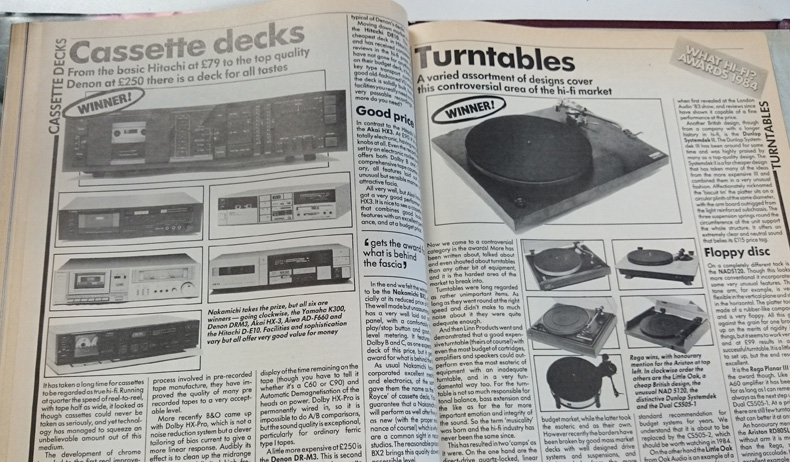
Before the CD came along, your main sources of music were cassette deck or turntable, yet both categories proved controversial back in 1983.
It took a while for cassette decks to be taken seriously in hi-fi circles, with the purists refusing to believe they could be "true" hi-fi. It was only when companies such as B&O, BASF and Dolby introduced new technical features to improve performance, and Japanese brands brought the necessary hardware, that they became a serious hi-fi consideration.
Aiwa, Akai, Denon, Hitachi, Nakamichi and Yamaha were the brands responsible for our favourite cassette players back in 1983. The £199 BX2 from Nakamichi - "the 'Rolls Royce' of cassette decks - took the top gong, thanks in no small part to a "comfortably large play/stop button". Sometime it's the little things.
Believe it or not, the turntables category was also considered "controversial" back in 1983. "Turntables were long regarded as rather unimportant items. As long as they went round at the right speed and didn't make too much noise about it they were quite adequate enough," our editorial noted.
Linn was credited with changing this mindset and giving birth to a whole new hi-fi category - but a divided one. Belt-drive decks were on one side, direct-drive on the other, and the merits of the two were debated over and over.
Brands such as Ariston, Dual, Dunlop and Little Oak featured, but the Rega Planar III got the nod in 1983. Back then, it was yours for the not-inconsiderable sum of £188.
Personals and portables
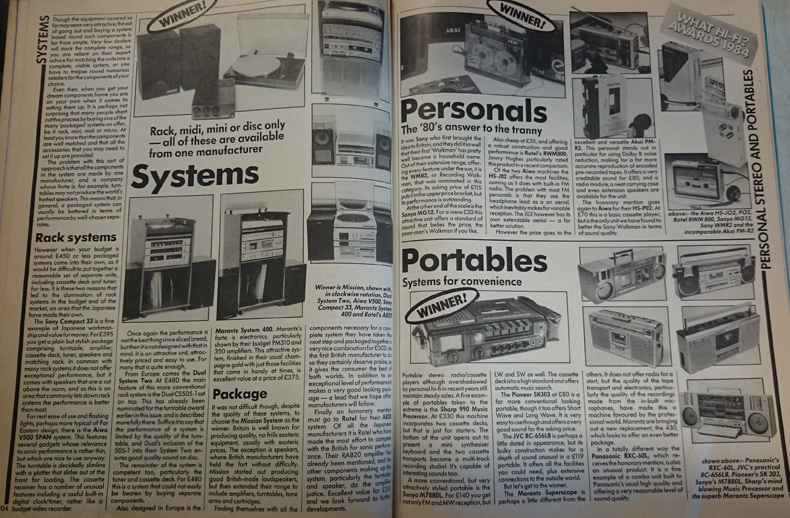
"Systems for convenience". How times have changed. The Sharp 990 Music Processor, one of the products nominated, incorporated two cassette decks, a mini synthesiser keyboard and "a multi-track recording studio". By today's standards, it really wasn't very convenient. Or, for that matter, portable.
Still, these big boomboxes were not to be sniffed at, with products such as the Marantz Superscope doubling-up as a decent recording machine thanks to an in-built mic, while also being a capable music system.
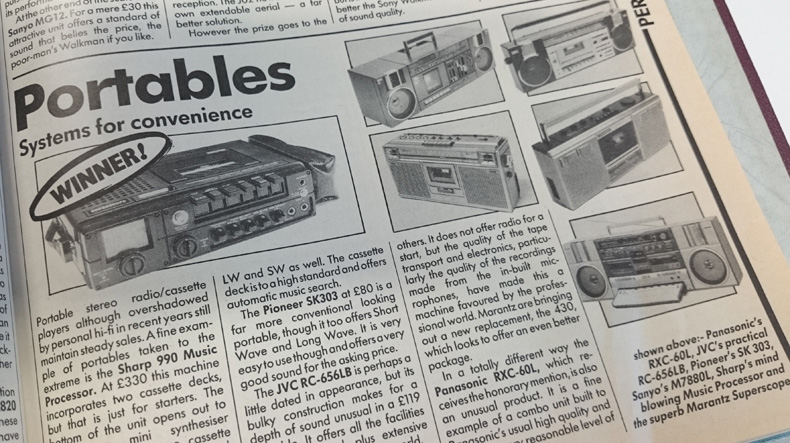
"The 80s answer to the tranny" was how we billed our portables category - a reminder that portable music was already up and running in 1983 in the shape of the compact cassette player.
Sony was credited with bringing the player to the mass market, and its WMR2 Walkman - a "Recording Walkman", no less - was one of our nominations. Aiwa, Akai, Rotel and Sanyo were the other brands making the best portable cassette players back then.
The winning Akai PM-R2 got particular approval for its Dolby B noise reduction, radio module, carrying case and separate external speakers. All for £80.
A far cry from the hi-res portable music players on sale now, and indeed the smartphones which replaced them and hastened the demise of the iPod Classic.
Most innovative
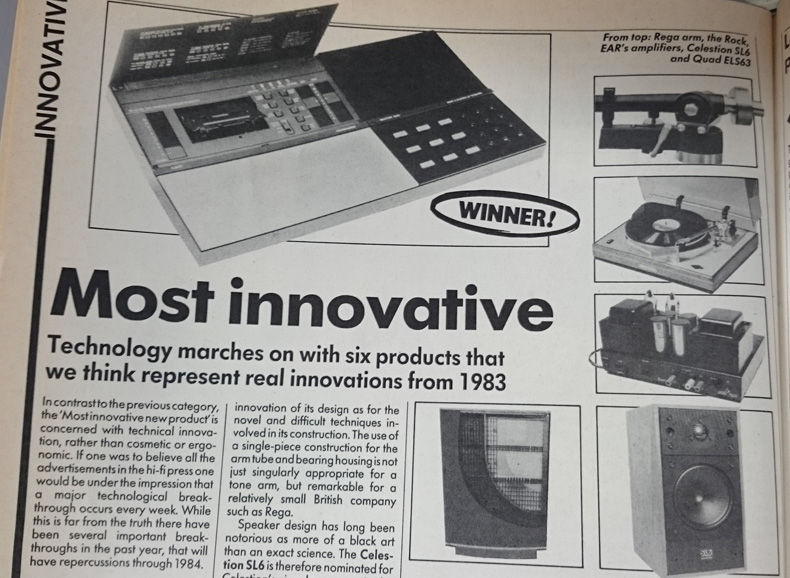
A look back to the six-strong shortlist for the 'Most innovative' category gives a snapshot of what was getting our juices flowing back in 1983.
The winning product was the B&O 9000 cassette deck. Well known for its innovation, Bang & Olufsen earned our praise for being the first manufacturer to feature Dolby HX-Pro. We noted this technology promised to bring "the cassette medium further into the hi-fi world".
Elsewhere, we picked out the classic Quad ELS63 electrostatic speakers, the Rega R300 tone arm (one of the first single-piece construction arms), the EAR 509 valve amplifiers ("valve technology taken to the limits") and the Elite Townshend The Rock turntable (one of the first decks to use a floating-platter style design, seen since on plenty of other turntables).
What next?
While the product categories and the number of winners may change, the way we pick them and our reasons for doing so remain broadly the same now as they did over 30 years ago.
As What Hi-Fi? editor Matt Nicholson said back in 1983: "Over the next year I think we will find that the hi-fi industry is changing faster than we know, and by the time the What Hi-Fi Awards 1985 come around, there will be a completely new set of products, surpassing even these, in the running."
That's truer now than ever. And it's why we will continue to highlight the best-value audio and video products on the market, no matter what shape that kit takes.
You can enjoy the latest example of this ethos when we announce this year's Best Buys...
MORE:
What Hi-Fi?, founded in 1976, is the world's leading independent guide to buying and owning hi-fi and home entertainment products. Our comprehensive tests help you buy the very best for your money, with our advice sections giving you step-by-step information on how to get even more from your music and movies. Everything is tested by our dedicated team of in-house reviewers in our custom-built test rooms in London, Reading and Bath. Our coveted five-star rating and Awards are recognised all over the world as the ultimate seal of approval, so you can buy with absolute confidence.

